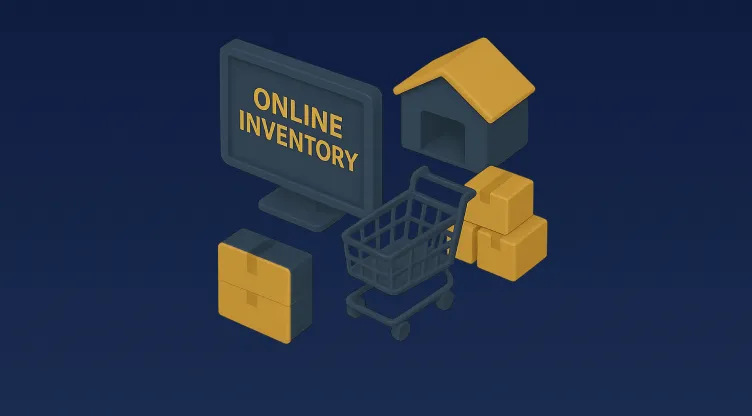2025 Guide to Online Inventory Management for Retail

Table of Contents
Winning Retailers Share What Works in Inventory Management
- Smart inventory practices help retailers scale faster and reduce operating costs.
- Track every product’s movement across warehouses, stores, and online channels.
- Avoid stockouts and overstock by syncing inventory with actual demand.
- Optimize fulfillment with centralized visibility across all locations.
- Use automation to streamline reordering and reduce human error.
- Sync inventory with POS, OMS, and WMS systems for smooth coordination.
- Gain SKU-level accuracy to ensure better reporting and decision-making.
- Use AI and analytics to forecast demand and adjust stock proactively.
Retail Runs Fast in 2025—Can Your Inventory Keep Up?
Were you aware that AI-driven tools can reduce stockouts by 30%? The question is simple— can your retail system match that pace in 2025?
Today’s retail landscape is moving fast and customers now expect every product to be available as they want it. They don’t like to see the “out-of-stock” pop-up for their product and this may result in lost sales, lower customer satisfaction, and missed revenue.
That’s why more retailers are turning to AI-powered inventory systems that predict demand, optimize replenishment, and cut waste—all in real time. The result? Fewer empty shelves and more happy customers.
But if you’re still using manual updates or old data, you’re already a step behind. In 2025, speed and accuracy won’t be a bonus—they’ll be the bare minimum**. **It’s time to ask: is your inventory solution equipped to adapt, learn, and scale like AI can? In this guide we will see how smart inventory management along with AI is reshaping retail inventory and what you can do to stay ahead.
Why Smart Inventory Management Is Non-Negotiable in 2025?
Imagine tracking inventories in all your warehouses real-time under a single dashboard? Fascinating, isn’t it? That’s what online inventory management does. It lets retailers track, update, and control stock levels across all sales channels in real time. It reduces errors, improves order accuracy, and helps ensure products are available when and where customers need them.
Here’s why you should not ignore it:
- Real-time visibility ensures customers always see accurate product details.
- AI inventory tools cut stockouts by predicting demand and automating reorders.
- Smarter inventory avoids overstocking, saving space and blocked capital.
- Unified inventory views helps with precise omnichannel fulfillment.
- Scalable systems support fast, efficient growth without any bottlenecks.

Features Retailers Can’t Afford to Miss
✅ Real-Time Inventory Tracking
Get instant updates across all sales channels to avoid stockouts and overstocking.
✅ AI-Driven Demand Forecasting
Predict customer demand accurately using historical data and real-time trends.
✅ Omnichannel Integration
Sync inventory, orders, and fulfillment across online, offline, and marketplace platforms.
✅ Automated Reordering
Set smart reorder rules to restock efficiently and prevent manual errors.
✅ Scalability and Flexibility
Choose tools that grow with your business and adapt to your needs.
✅ Data-Driven Dashboards
Access actionable analytics to improve inventory planning and performance.
✅ Easy Mobile Access
Manage inventory on-the-go with mobile-friendly dashboards and tools.
✅ Third-Party App Integration
Ensure smooth connectivity with ERPs, WMS, shipping, and accounting software.
✅ Robust Security and Compliance
Protect data with strong security features and ensure compliance with global retail standards.
✅ User-Friendly Interface
A simple, intuitive design makes onboarding and daily use easier for your team.
Key Components of Scalable Online Inventory Solution
Can your inventory system keep up when business suddenly picks up or the holiday rush hits? If you're not sure what makes an online system scalable, don't worry. Let’s break down the key features that help your inventory stay in control as your business grows.
Real-time Inventory Tracking
A scalable system starts with a cloud-based platform you can access anytime, from anywhere. It brings all your inventory data into one place—no more jumping between spreadsheets or systems. Stock updates happen in real time, so you always know what’s where.
Even partially completed orders or in-progress stock (WIP) are tracked accurately with features like live location reports. This helps cut down on manual work and prevents surprises.
Barcodes and SKUs speed up product tracking and make stock counts, reorders, and deliveries more accurate. The result? A faster, smoother inventory process that’s ready to scale when you are.
Order Management & Inventory Optimization
An AI-driven online inventory management system integrates seamlessly with your sales channels—automatically syncing orders from your online store and marketplaces. This multichannel visibility goes beyond a high-level view, offering real-time tracking from order placement to delivery, along with instant alerts for low stock, delays, and fulfillment issues.
More than just stock tracking, AI tools enable demand forecasting by analyzing past sales trends to predict future needs—helping you avoid stockouts and overstocking.
With automated reordering, you can set smart reorder points and let the system trigger purchase orders the moment inventory dips below threshold—keeping your stock optimized with minimal manual effort.
Reporting and Analytics
Smart online inventory tools powered by AI help you see what’s really happening in your business. You get clear, real-time reports on things like what’s selling, what’s not, how much stock you have, and what needs attention.
You can even customize these reports to track product sales, stock value, or slow-moving items, so you can make smarter decisions faster.
With tech like RFID and barcode scanners, tracking stock becomes easy and accurate—no more manual errors. And if you're handling sensitive items, IoT sensors can monitor factors such as temperature and humidity, sending you alerts before any issues arise.
Together, these tools make inventory management smarter, simpler, and ready to grow with your business.
Multichannel Integration
With omnichannel retail becoming the norm, AI-powered systems must integrate with e-commerce platforms, POS systems, and marketplaces. Integrations with tools like Shopify, WooCommerce, and Amazon enable real-time inventory sync, automated order processing, and shipping with live rate calculations, label generation, and tracking.
These systems also connect with your accounting software to automate financial reporting and inventory valuation.
By unifying data across online and offline channels, you ensure inventory accuracy, prevent overselling, and maintain optimal stock levels—across the entire business ecosystem.
Need Smart Inventory Tools? Start with These 3
-
Omniful.ai— One Smart System for All Your Inventory Needs
Omniful.ai is the most inventive and comprehensive AI-powered e-commerce inventory management system for all businesses. This system is designed for individuals who own retail, commerce, or logistics businesses.
It is a solid e-commerce inventory management solution that offers:
Unparalleled Omnichannel Capabilities:
- Real-time order routing across multiple sales channels
- AI-driven inventory optimization for multi-warehouse operations
- Seamless integration with 100+ shipping providers worldwide
Advanced Warehouse Management:
- AI-powered picking route optimization
- Real-time inventory tracking with lot & expiry date management
- Support for high-volume throughput in various retail environments
Intelligent Transportation Management:
- Advanced route optimization for hyperlocal and cross-city deliveries
- Real-time driver and package tracking
- Automated order batching and vehicle capacity management
Integrated Point of Sale:
-
Multi-location, multi-register support with e-invoicing capabilities
-
Seamless integration with OMS for actual omnichannel operations
-
Real-time reporting and insights for data-driven decision-making
Omniful's cloud-native architecture and modular approach enable your business to scale effortlessly, starting with essential features and expanding as needed. With Omniful.ai's AI-powered capabilities and comprehensive feature set, Omniful.ai is at the forefront of retail inventory management and e-commerce operations.

-
Zoho Inventory— Makes Scaling Your Inventory Simple
Zoho Inventory is a very popular cloud-based inventory management system for small to medium-sized e-commerce businesses.
See What Zoho Offers:
-
Consolidate your inventory management across sales channels
-
Automate reordering based on your stock levels
-
General demand forecasting
-
Integration with Zoho's suite of business applications
Zoho Inventory looks exhaustive on the surface. The truth is that it lacks some of the core advanced AI & automation features offered by Omniful for larger enterprises.
-
Cin7— Your Business’s Secret Weapon
Cin7 is an inventory and order management platform developed for mid-market multichannel sellers.
You Can Use It For:
- Inventory control
- Order processing
- Supply chain management
Key Elements Include:
-
EDI and B2B order management
-
Manufacturing and assemblies
-
Extensive integration options
Cin7 offers an umbrella-like functionality, but it may require a more complex setup and configuration compared to Omniful's plug-and-play approach for rapid deployment, which is preferable for most.
How Do Experts Organize Inventory? Try These Smart Tips
No two products are alike; some products are your cash cows, and some products soak up your working capital. Research has found that $300 billion in revenue is lost due to markdowns. To make the best use of your money, you need to manage inventory well—keeping your top-selling products in stock and only holding enough low-value items to sell steadily.
Here are some ways that you can try in your business:
Start with ABC's
ABC analysis is a core concept in the basics of inventory management based on the Pareto principle, which suggests that roughly 80% of effects come from 20% of causes. So, how does that translate for online inventory management? Well, it helps you prioritize your inventory based on its value; it can be categorized into three categories:
- A-items: High-value, contribute most to revenue (around 80%) but represent a smaller portion of inventory (around 20%). It needs careful monitoring and accurate forecasting.
- B-items: They have moderate value & contribute a moderate amount to revenue. Requiring less attention than A-items.
- C-items: These are low-value items that make up a large portion of inventory but contribute the least to revenue. They require the least amount of attention and can be managed with simpler controls.
ABC analysis helps you understand how to manage inventory effectively by keeping your focus on high-value items, optimizing stock levels, and improving stock forecasting, which leads to better resource allocation and an increase in profitability.
Just-in-time Inventory Management: Lean and Agile
Just-in-time (JIT) is an approach where goods are received only when required for production or sales. The Just-In-Time (JIT) technique helps your business minimize storage costs and reduce resource wastage. This, in turn, will make it a worthwhile inventory management practice for any retail business.
You will reduce the risk of overstocking on deadstock (that one item on your shelves, no matter what that doesn't sell) and free up your working capital by receiving inventory "just in time."
The tactic requires precise demand forecasting and a strong supplier relationship. This makes it a crucial part of modern inventory management practices aimed at optimizing stock levels and enhancing the overall operational efficiency of your business.
Future-Proof Your Retail Inventory in 2025 With Omniful
Online inventory management is no longer a pipe dream or luxury for managing the inventory; it is a necessity for small to large business owners. One such platform that empowers retailers with its features is Omniful.
It offers real-time visibility, AI-powered demand forecasting, automated reordering, and seamless multichannel integration—all within one unified platform. Whether you're managing online orders, physical stores, or both, Omniful helps you reduce stockouts, avoid overstocking, and respond faster to market demands.
FAQs
1. What's the simplest way to get started with online inventory management?
It helps boost sales by keeping products in stock and avoiding overselling. With real-time data, smart demand forecasts, and auto reordering, you can meet customer needs quickly and make shopping smoother.
2. Can online inventory management software help with omnichannel selling?
Yes, online inventory management software is built to support omnichannel selling by syncing inventory across all your sales channels—online stores, marketplaces, and physical outlets. It ensures accurate stock levels, faster order fulfillment, and a smooth customer experience everywhere you sell.
3. How can online inventory management improve my sales?
It can improve your sales by ensuring products are always in stock, reducing overselling or stockouts. With real-time data, demand forecasting, and automated reordering, you can meet customer demand faster and deliver a smoother buying experience.
4. How has AI changed inventory management in 2025?
With AI in 2025, businesses can now automate demand forecasting, reordering, and stock optimization that leads to reduced human error and increased efficiency across all channels.
5. Is online inventory management only for large businesses?
Not at all. Scalable platforms like Omniful, Zoho Inventory are designed for businesses of all sizes, with features that grow with your needs. Assess your business needs and make the switch today.
6. How do I choose the right inventory platform for my business?
Selecting the right one for your business can be daunting at times. However, to finalize a proper inventory platform you must evaluate the options based on ease of use, integration capabilities, automation features, and how well they support your sales channels.























